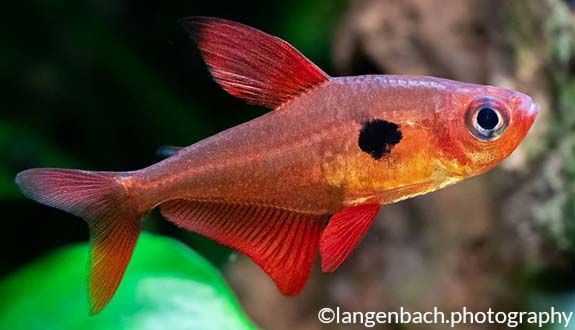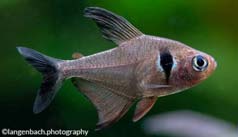

Alternative species (click on the thumbnail to see the card)
Names
Scientific name
Hyphessobrycon sweglesi
Megalamphodus sweglesi
Common name
Red phantom tetra
Origin

Origin: Venezuela and Colombia
Biotope: Amazonian
Dimorphism

Females have a white spot at the end of their dorsal fin. The male's is longer and edged in black (see "Good to know").
Group

GCharacidae
Volume

120 L / 26 Imp Gal / 32 Us Gal
Parameters

T°: 20 to 23°C or 68 to 73°F
pH: 6.5 to 7
Hardness: 1 to 12°dGH
Difficulty

Easy
Size

4cm (1.6")
Longevity

4 to 5 years
Living zone

Depth
Individuals

10
Food
How to feed the Red phantom tetra?
Food
How to feed the Red phantom tetra?
Very easy to feed, this omnivorous fish accepts all types of food: flakes or granules, artemia, mud worms, red daphnia (these last ones improve the coloration of your fish, don't hesitate!)... To promote better health, all you have to do is vary the menus frequently!
Behavior
What kind of behavior does the Red phantom tetra have?
Behavior
What kind of behavior does the Red phantom tetra have?
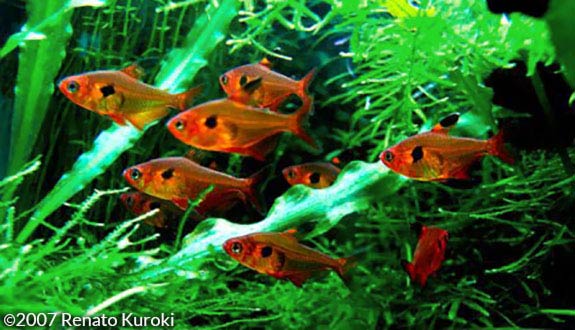
The Red phantom tetra has a calm, peaceful and sociable temperament.
Interspecific social interactions are interesting, and males often parade all their fins outdoors. These battles remain perfectly harmless to the protagonists.
Unlike many Tetra, the Red phantom tetra will preferably stay close to the floor of the aquarium, where it moves around in a shoal.
Cohabitation
Who can live with the Red phantom tetra?
Cohabitation
Who can live with the Red phantom tetra?
The first rule of cohabitation for this species is that it must be kept in groups of at least 10 individuals! But if your volume allows it, increase the size of your group. The more they are numerous, the more the spectacle they offer you is a delight!
For association with other species, any other fish with a peaceful temperament will be able to live harmoniously with it. Be careful however with the predation of big fish and its intense activity which can disturb some calmer fish like Corydoras (the Red phantom tetra can sometimes be turbulent). Juvenile shrimp will serve as snacks. So avoid them!
Breeding
How to breed the Red phantom tetra?
Breeding
How to breed the Red phantom tetra?
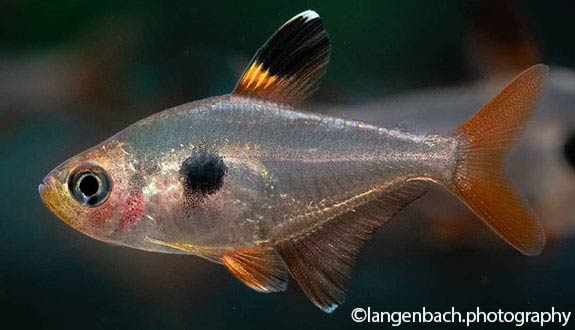
As for its cousin the Black phantom tetra (Hyphessobrycon megalopterus), the reproduction of this species is quite difficult (due to fertilization problems). We propose here the same protocol.
Prepare a 20-litre (4 Impg Gal / 5 US Gal) aquarium equipped with a small filter (perlon + peat), an immersion heater and fine-leaved plants such as java moss and Myriophyllum. Use floating plants to strongly dim the light because the aquarium must be very dark (eggs are afraid of light). The ideal water parameters are a temperature of 24°C (75°F) and a pH of 6/6.5 and a Gh of 5. If necessary, use osmosis water to achieve these parameters.
Introduce a couple that you have selected into this tank, preferably in the evening (they should be between 8 and 10 months old for a better chance of success). The spawning is very visible, the male coming to stick to the female's side. The female expels about 200 eggs by making sharp turns. The eggs come to stick to the plants. They are brown/red. As soon as they appear, remove the parents and be very careful with the light that deteriorates the eggs (do not hesitate to protect your breeding aquarium more at this stage).
Incubation lasts 24 hours. At birth, the fry tend to remain at the bottom of the tank and then settle on the surface. They swim freely after the 6th day, but most of the time they remain hidden in the plants. The growth is rather slow.
Gradually add harder water to accustom the young. Do the same for the light, which should return gradually.
Feeding the fry: infusers, small nauplias of artemia or cyclops for at least 5 weeks.
Its aquarium
Which aquarium for the Red phantom tetra?
Its aquarium
Which aquarium for the Red phantom tetra?
First of all, even if this fish does not require large volumes, choose an aquarium with at least 80 cm (31.5") of frontage so that there is enough swimming space.
A well-planted aquarium is essential for the well-being of this Tetra. So, plant your tank densely on its sides and at the bottom. This will leave a clear swimming space. Garnish with some nice bog roots that form many hiding places.
As these fish do not like brightly lit environments, do not hesitate to introduce floating plants in your aquarium. This will dim the lighting and make your fish feel safe.
For the floor, opt for a dark colour that will not only make your fish feel safe, but will also enhance them!
Despite its robustness, make sure you maintain good water quality. Indeed the Red phantom tetra is quite sensitive to water pollution. Change the water frequently, making sure that the new water has the same parameters as the aquarium water.
Good To know
Find all additional information!
Good To know
Find all additional information!
Quite sensitive to variations in water parameters, as well as too hot water which can be fatal in the long term. It can nevertheless be proposed to conscientious beginner aquarists.
This fish belongs to the large family of Characidae, which lists more than 1000 species!
There is an albino variety of this species.
The sexual dimorphism is quite obvious:
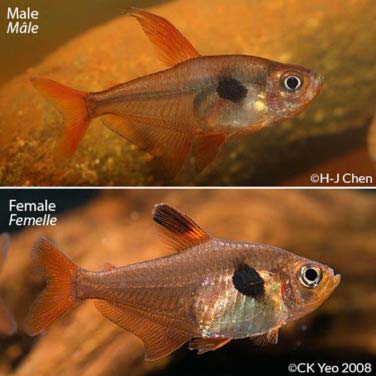
Yours photos!
Comments
Sort by:
Please login to post comments
